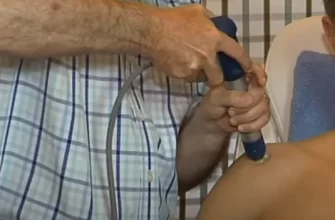Shockwave therapy is a medical procedure that doesn’t require surgery and employs powerful sound waves to promote the body’s own recovery mechanisms.
Originally created in the 1980s to fragment kidney stones, its capabilities have now been acknowledged for addressing a range of musculoskeletal disorders.
Health Issues Addressed Through Shockwave Treatment
Shockwave therapy is a medical procedure that doesn’t involve surgery and is very effective for a range of conditions affecting the muscles and bones. It’s been used with success to address multiple health issues.
- Shockwave Therapy for Plantar Fasciitis: This treatment can help to ease the discomfort and swelling linked to plantar fasciitis. It works by promoting the healing of tissues and lessening the strain on the plantar fascia.
- Tendon inflammation, including conditions like Achilles tendon inflammation and lateral epicondylitis, can be successfully managed using shockwave therapy. This treatment aids in recovery and alleviates discomfort by enhancing circulation to the impacted region.
- Shockwave therapy has displayed encouraging outcomes in the management of bursitis, as it appears to diminish inflammation and aid in the healing of tissues.
- Persistent Discomfort: People enduring ongoing pain in their joints or muscles might find relief through shockwave therapy. This treatment encourages cellular regeneration, improves blood flow, and reduces the intensity of pain experienced.
- Shockwave Treatment for Musculoskeletal Conditions: Various ailments affecting the body’s muscles and skeleton, including stiff shoulder and pain in the hip, have been treated successfully with shockwave therapy, offering significant pain reduction and enhancing movement.
Summary of Advantages Provided by Shockwave Therapy
Shockwave therapy provides multiple advantages for those dealing with different musculoskeletal issues. Below are some of the main perks:
- Alleviating Discomfort: Shockwave therapy mitigates discomfort by diminishing swelling and encouraging the healing of tissues. This treatment option is capable of offering enduring respite for ailments including plantar fasciitis, tendonitis, bursitis, and persistent pain conditions.
- Shockwave Therapy as a Non-Surgical Option: This therapy method does not involve surgery, avoiding the need for cuts or the use of anesthesia and thus, reducing the dangers often linked with surgical interventions.
- Brief Therapy Duration: Sessions of shockwave therapy are generally quick, often concluding within a matter of minutes. This is particularly advantageous for people with packed agendas, as they may not have the luxury to dedicate extended periods to therapeutic treatments.
- Enhanced Healing Speed: Shockwave therapy facilitates quicker healing by boosting circulation to the targeted region and encouraging cell renewal, resulting in reduced healing durations when compared to conventional therapies.
- Enhanced Movement: Shockwave therapy aids in enhancing the flexibility and movement of joints by alleviating discomfort and swelling. This treatment can be especially useful for those suffering from musculoskeletal conditions such as stiff shoulder or discomfort in the hip area.
How to Prepare for Shockwave Therapy
Before receiving shockwave therapy, adhering to specific preparatory instructions is crucial for achieving the best outcomes and reducing the likelihood of any hazards. Below are some recommendations to get ready for shockwave therapy:
- Appointment setup: Arrange a first meeting with a medical expert proficient in shockwave therapy. This practitioner will assess your medical issue and decide whether this therapeutic approach is appropriate for you.
- Medical Background: It is important to give a full account of your health history, listing all medicines, supplements, or known allergies. This detail is essential for the medical provider to customize your care plan to meet your individual health requirements.
- Hydration: Ensure you drink ample water prior to your therapy appointment to maintain good hydration. Being well-hydrated aids in improving blood flow and the healing of tissues, which can boost the impact of the shockwave treatment.
- Analgesic Advisory: Refrain from using non-steroidal anti-inflammatory drugs (NSAIDs) or alternative pain relievers prior to your appointment unless your medical provider instructs you differently. Such drugs can conceal feelings of discomfort and disrupt the evaluation of how well the treatment is working.
- Apparel: Opt for relaxed and cozy garments that permit effortless entry to the part of the body receiving treatment. This makes it simpler to apply the gel and guarantees the highest level of comfort throughout the procedure.
- Take away any metallic accessories or jewelry: It’s important to remove all pieces of jewelry or any metallic objects in close proximity to the area that will receive the treatment to prevent any potential disruptions in the administration of shockwaves.
By adhering to these preparatory guidelines, you can enhance the effectiveness of your shockwave therapy and guarantee a seamless treatment process.
Safety and Procedure Success Rate
Shockwave therapy has been proven to be a secure and efficient method for treating a variety of health issues. A substantial amount of research and clinical testing has confirmed the beneficial results of this treatment approach.
From a safety perspective, shockwave therapy is regarded as a slightly obtrusive technique featuring a minimal likelihood of adverse outcomes. This therapy is a non-operative approach that eliminates the need for cuts, thereby diminishing the probability of infection or scar formation. Nonetheless, as is common with any medical procedure, patients might experience minor temporary side effects, including discomfort, skin reddening, or bruising at the application site. Such reactions generally subside within several days.
In terms of successful treatment, shockwave therapy has shown positive results for healing issues such as plantar fasciitis, tendon-related injuries, pain in bones or muscles, and issues with male sexual performance. The procedure encourages the body to heal itself by using sound waves directed at the problem area. This enhances circulation, repairs tissues, and alleviates discomfort.
It should be recognized that outcomes can differ from person to person, influenced by elements like the intensity of the ailment and how well the patient responds to therapy.
Conclusion
In summary, the use of shockwave therapy has proven to be a reliable and beneficial method for treating different health issues. By utilizing sound waves, this non-invasive technique encourages the body to heal itself and aids in the restoration of tissues.
Research and medical tests have repeatedly shown favorable results for issues like plantar fasciitis, various tendon disorders, bodily pain involving the muscles and bones, and problems with erectile dysfunction (ED). This treatment provides several advantages, such as better circulation, decreased discomfort, and improved general performance.
One should be aware that personal outcomes can differ depending on elements like the intensity of the issue and how one personally reacts to therapy. Seeking advice from a medical expert with expertise in shockwave therapy can aid in assessing whether this treatment is suitable for your specific situation.
Shockwave therapy, being a less invasive option with a reduced chance of side effects, offers a substitute for more intrusive surgical interventions. Nonetheless, it is crucial to adhere to the necessary guidelines for preparation before the treatment and care after the treatment as advised by your healthcare professional.









